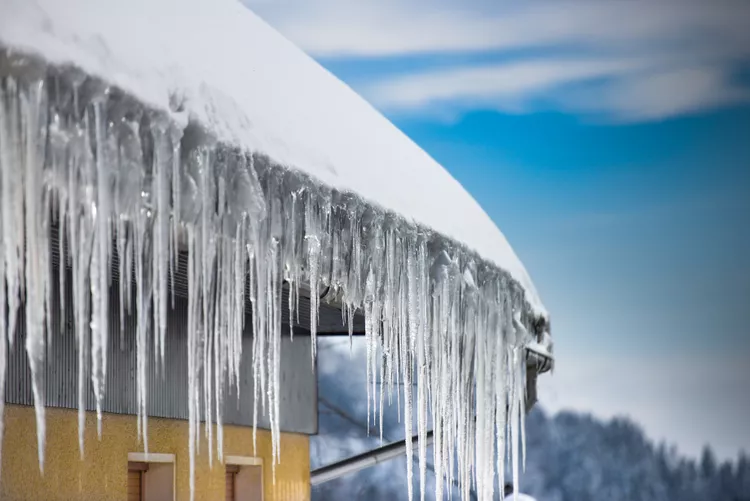How to Prevent and Remove Ice Dams from Your Roof

Ice dams form when snow that has accumulated on the roof melts and runs down to the gutter system. As the meltwater runs into the gutter system, it cools and begins to freeze. Gradually, ice builds up in the gutter, forming an ice dam. When this occurs, the weight of the ice can damage the gutter system.
Additionally, the ice dam prevents water from draining away from the home, causing water to seep through the shingles, where it freezes, expands, and ultimately loosens the shingles. Once this happens, the water can work its way into the roof, causing extensive water damage, wood rot, and mold growth. Here’s how to prevent and remove ice dams from your roof.
What Is an Ice Dam and How Do They Form?
An ice dam is essentially a block of ice that forms in the gutter system of the home. As it grows, it prevents the gutter system from draining water away from the house. It can also damage the roof, put excessive weight on the gutter system, and lead to water damage and wood rot.
Ice dams form because of a difference in temperature between the roof and the eaves. Usually, a third of all heat that escapes from the home passes through the attic before exiting through the roof. This heat increases the temperature of the roof, causing the snow to melt. However, the temperature of the eaves is typically lower than the roof’s temperature, so the meltwater flows into the eaves and freezes, gradually building to the point of becoming an ice dam.
If there is a significant temperature difference between the roof and the eaves, ice damming will likely occur. The greater the difference, the higher the chance of ice dam formation. With this in mind, learning how to prevent and remove ice dams is important.
Safety Considerations
When dealing with an existing ice dam, DIYers and professionals must be careful to avoid damaging the roof or being injured during removal.
The person breaking up the ice dam should work from a safe vantage point on the roof, ensuring they are securely connected to fall-arrest equipment to prevent injury if they slip or trip. Additionally, DIYers should never substitute rock salt for calcium chloride when melting the ice dam. While calcium chloride is safe for roof shingles and vegetation, rock salt poses a risk to the home and plant life.
Ways to Remove Ice Dams
1. Melt Ice Dams with Calcium Chloride
Using a chemical compound to melt ice dams is an excellent way to remove this problem, though it’s essential to find products that are safe for use on shingles and around vegetation. With this in mind, the DIYer should never use rock salt for this purpose. Instead, use calcium chloride or a similar ice-melting product.
Fill a long tube sock or pantyhose legging with calcium chloride, tie off the ends with string, and hang each sock over the dam. You can use a roof rake or a similar tool to position the sock to hang an inch or two over the roof edge. As the calcium chloride melts the ice, it creates a channel through the dam, allowing any additional water to flow freely. However, the channels may fill up quickly if there is further snowfall in the following days, so it’s important to keep the roof clear of snow with a roof rake while the ice dam is melting.
2. Melt Ice Dams with Hot Water or Steam
Hot water is one of the best ways to remove an ice dam. There is little risk of the water harming the vegetation or roofing shingles, but this process can take a while for a DIYer to complete. Start by connecting a garden hose to the hot water outlet for the laundry tub or washing machine. Carry the garden hose up to the ice dam and begin gradually melting the ice dam with the hot water. Avoid directing the pressurized water directly against the shingles, as this can cause the shingles to lift and pull away from the roof.
Homeowners can hire professionals to melt the ice dam with hot water or by using commercial steaming equipment. Pros have the knowledge and experience to eliminate the ice dam quickly and efficiently while following detailed safety protocols to avoid injury.
3. Break Up the Ice Dam
While it is possible to physically break up an ice dam by carefully using a mallet and chisel, this method is significantly more dangerous than attempting to melt the ice dam. This method isn’t suggested for DIYers because they may damage the roof or gutter system while banging away with a hammer, leading to more problems in the future. Additionally, breaking an ice dam can cause large icicles, sheets of ice, and chunks of ice to slide or drop from the roof, putting the DIYer and anyone nearby at risk.
If breaking up the ice dam seems like the best option, then it’s best to call a professional crew to handle the job. Pros have the experience, skills, and proper tools readily available to tackle this type of work, so there is less risk of injury or damage to the property.
